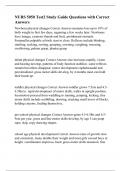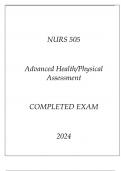Nurs 505 - Study guides, Class notes & Summaries
Looking for the best study guides, study notes and summaries about Nurs 505? On this page you'll find 118 study documents about Nurs 505.
Page 4 out of 118 results
Sort by

-
NURS 505 FINAL EXAM 2024-2025|ACTUAL COMPLETE EXAM QUESTIONS WITH WRITTEN EXPERT CERTIFIED SOLUTIONS TO EACH PROBLEM |ALREADY GRADED A+
- Exam (elaborations) • 53 pages • 2024
-
- $27.99
- + learn more
NURS 505 FINAL EXAM |ACTUAL COMPLETE EXAM QUESTIONS WITH WRITTEN EXPERT CERTIFIED SOLUTIONS TO EACH PROBLEM |ALREADY GRADED A+ NURS 505 FINAL EXAM |ACTUAL COMPLETE EXAM QUESTIONS WITH WRITTEN EXPERT CERTIFIED SOLUTIONS TO EACH PROBLEM |ALREADY GRADED A+ NURS 505 FINAL EXAM |ACTUAL COMPLETE EXAM QUESTIONS WITH WRITTEN EXPERT CERTIFIED SOLUTIONS TO EACH PROBLEM |ALREADY GRADED A+ NURS 505 FINAL EXAM |ACTUAL COMPLETE EXAM QUESTIONS WITH WRITTEN EXPERT CERTIFIED SOLUTIONS TO ...
NURS 5050 Bundle Package
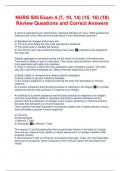
-
NURS 505 Exam 4 (7, 10, 14) (15, 16) (18) Review Questions and Correct Answers
- Exam (elaborations) • 7 pages • 2024
-
- $9.99
- + learn more
A client is experiencing an inflammatory response following an injury. What assessment finding would confirm the role of thromboxanes in the inflammatory process? a) Bleeding has stopped at the injury site b) The skin surrounding the injury site has become reddened c) The client's pain is steadily decreasing d) The client's heart rate and blood pressure have risen a) bleeding has stopped at the injury site Platelet aggregation and blood clotting are the result of the action of thromboxanes. ...
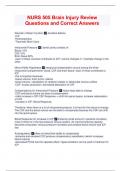
-
NURS 505 Brain Injury Review Questions and Correct Answers
- Exam (elaborations) • 6 pages • 2024
-
- $9.49
- + learn more
Disorder of Brain Function -Cerebral Edema -ICP -Hydrocephalus -Traumatic Brain Injury Intracranial Pressure Cranial cavity consists of: Blood: 10% CSF 10% Brain tissue 80% -each of these volumes contributes to ICP- volume changes in 1 facilitate change in the other. Monro-Kellie Hypothesis -reciprocal compensation occurs among the three intracranial compartments- blood, CSF and brain tissue- each of these contributes to ICP -this is important because: -tissue volume- brain tumor, edema -blood...

-
NURS 505 ATI Week 3 Test Questions and Correct Answers
- Exam (elaborations) • 5 pages • 2024
-
- $8.99
- + learn more
A nurse on a medical-surgical unit has received change-of-shift report and will care for four clients. Which of the following tasks should the nurse assign to an assistive personnel (AP)? A. Updating the plan of care for a client who is postoperative B. Reinforcing teaching with a client who is learning to walk using a quad cane C. Reapplying a condom catheter for a client who has urinary incontinence D. Applying a sterile dressing to a pressure injury C. Reapplying a condom catheter for a clien...
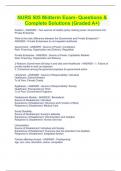
-
NURS 505 Midterm Exam- Questions & Complete Solutions (Graded A+)
- Exam (elaborations) • 7 pages • 2023
-
- $6.99
- + learn more
NURS 505 Midterm Exam- Questions & Complete Solutions (Graded A+) NURS 505 Midterm Exam- Questions & Complete Solutions (Graded A+) Dualism - ANSWER - Two sources of healthy policy making power: Government and Private Enterprise What is the main difference between the Government and Private Enterprise? - ANSWER - Private Enterprises do not regulate healthcare Government - ANSWER - Source of Power: Constitution Role: Financing, Organization and Delivery, Regulation Private Enterpris...
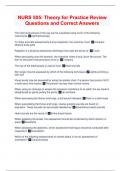
-
NURS 505: Theory for Practice Review Questions and Correct Answers
- Exam (elaborations) • 5 pages • 2024
-
- $8.99
- + learn more
The internal structures of the eye can be visualised using much of the following instruments Ophthalmoscope To make accurate assessments during inspection, the examiner must: Compare bilateral body parts Palpation is a physical assessment technique that uses the sense of: Touch When percussing over the stomach, the examiner notes a loud, drum-like sound. The term to document this percussion tone is: Tympany The eye of the stethoscope is used to hear: Heart sounds Skin turgor may be assessed...
NURS 505 ADVANCED HEALTH(PHYSICAL ASSESSMENT) COMPLETED EXAM 2024.NURS 505 ADVANCED HEALTH(PHYSICAL ASSESSMENT) COMPLETED EXAM 2024.

-
NURS 505 Exam 2 PrepU Questions (50-52) (37)
- Exam (elaborations) • 12 pages • 2024
-
- $8.59
- + learn more
NURS 505 Exam 2 PrepU Questions (50-52) (37) A patient with a longstanding diagnosis of chronic renal failure has experienced a significant decline in urine output in recent days, prompting him to seek care at a local clinic. A nurse at the clinic has suggested to a colleague that the administration of a diuretic such as hydrochlorothiazide may improve the patient's urine output. How should the colleague best respond to this suggestion? a) "That would probably help, but we'd have to do ...

-
NURS 505 Final - Perioperative Nursing Review Questions and Correct Answers
- Exam (elaborations) • 3 pages • 2024
-
- $8.99
- + learn more
Mrs. Ogg requires surgery for treatment of a ruptured spleen as the result of an automobile crash. This type of surgery belongs in which of the following categories? a. Minor, diagnostic b. Minor, elective c. Major, emergency d. Major, palliative c. Major, emergency A general anesthetic is given for specific purposes during a surgical procedure. Which one of the following purposes is not included? a. Loss of consciousness b. Relaxation of skeletal muscles c. Reduction of reflex action d. Locali...

How much did you already spend on Stuvia? Imagine there are plenty more of you out there paying for study notes, but this time YOU are the seller. Ka-ching! Discover all about earning on Stuvia

